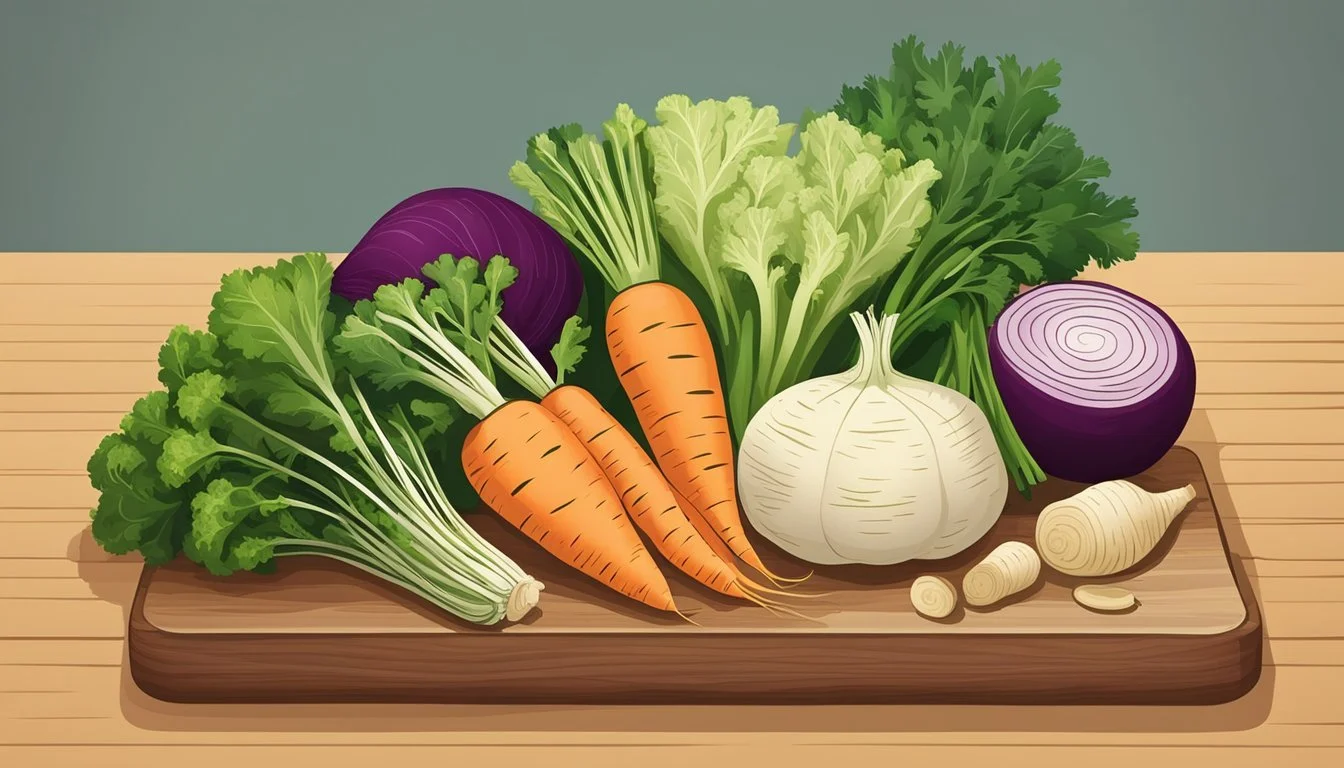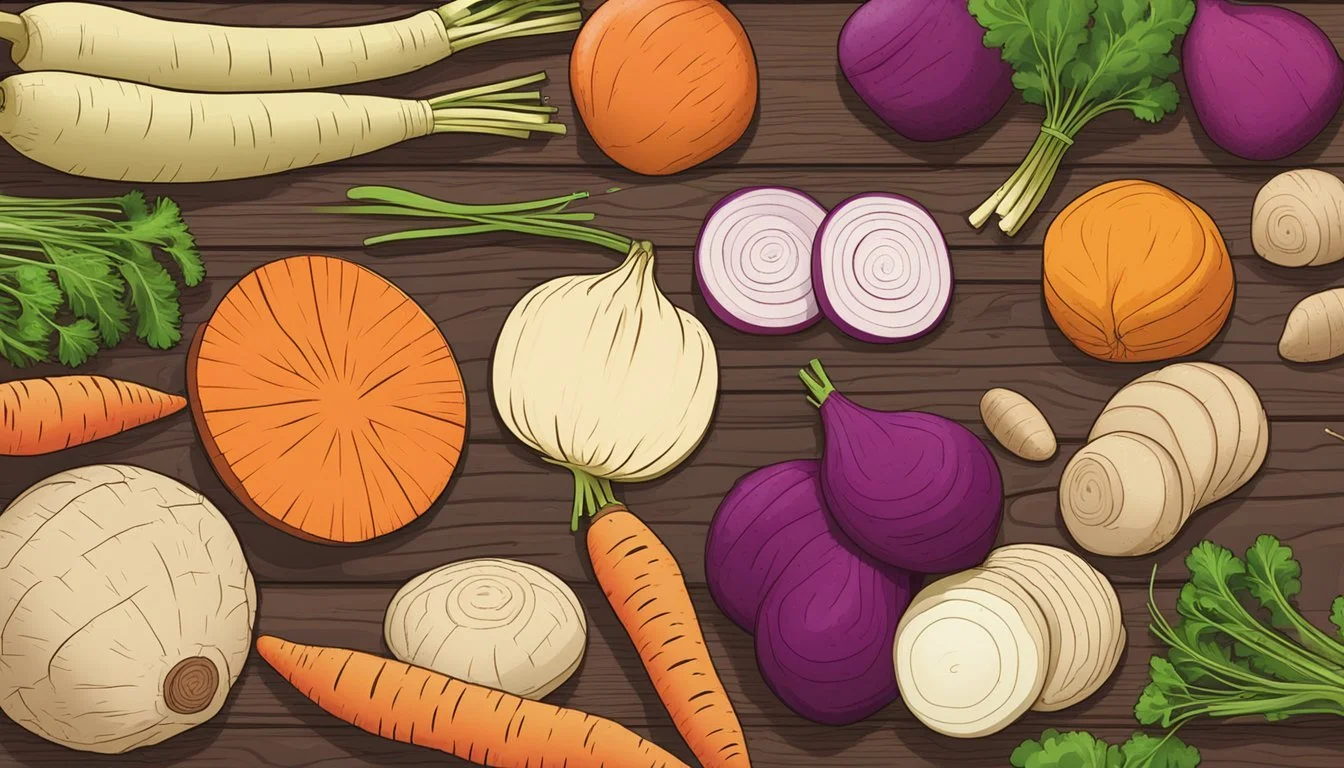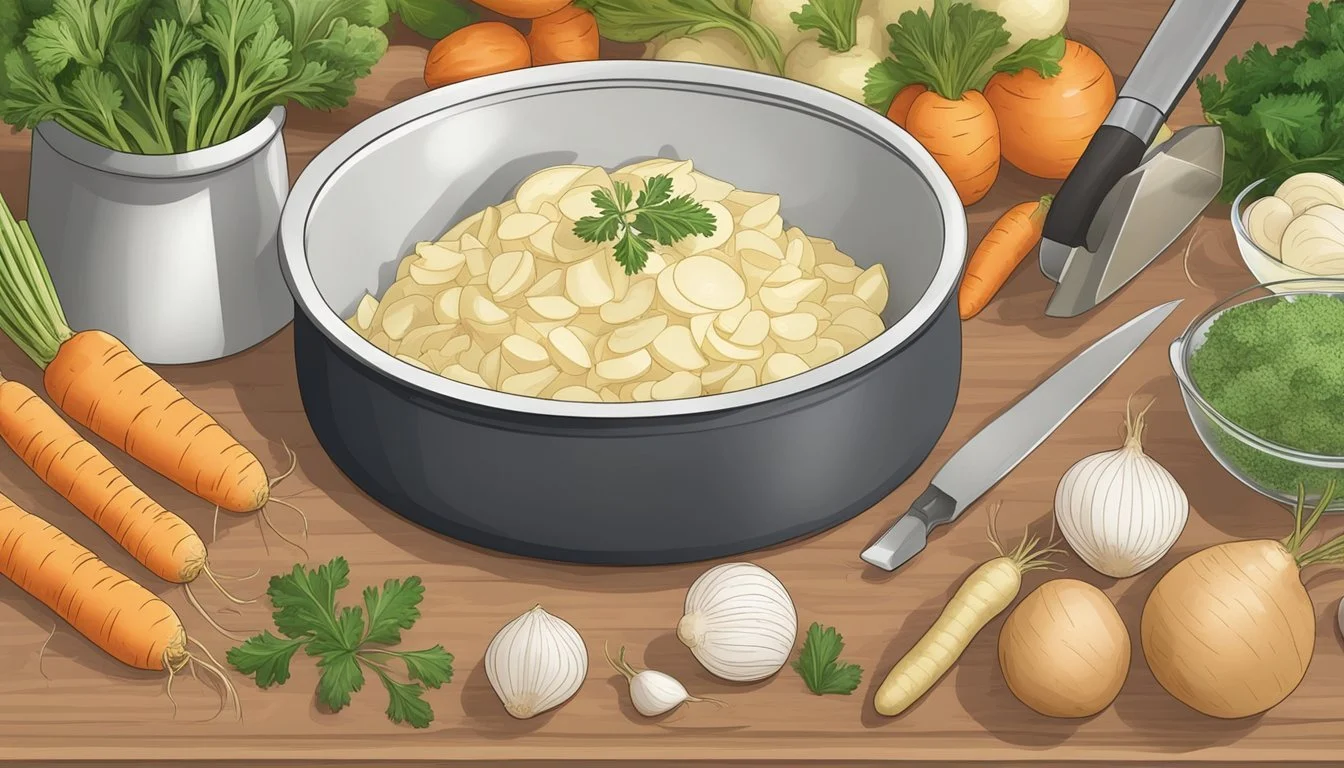Parsnip Substitutes
Top Alternatives for Your Recipes
Parsnips are a distinct root vegetable known for their sweet flavor, which intensifies upon cooking. Serving as a staple in many kitchens, especially throughout the fall and winter months, they are often incorporated into stews, soups, and roasted vegetable assortments. The creamy texture and woodsy, sweet taste of parsnips make them a prized component for a variety of dishes. However, due to availability, dietary preferences, or a desire to experiment with different flavors and textures, cooks may seek suitable substitutes.
Several vegetables offer a similar profile and can be substituted for parsnips in recipes without compromising the dish’s integrity. Carrots are the closest relative to parsnips and can be used as a direct substitute due to their shape and size. They lend a similar sweetness but may require slightly less cooking time. White carrots closely mimic parsnips in both appearance and texture, making them another excellent alternative. Moreover, vegetables like parsley root, turnips, and salsify are also considered good replacements, offering their unique flavors while maintaining the dish's overall character.
When substituting for parsnips, one must consider the distinct flavors and cooking times of the alternatives. The chosen substitute may influence the final taste and texture of a dish subtly or significantly. Adjustments in cooking times and seasoning may be necessary to closely replicate the desired outcome typically achieved with parsnips. Understanding the properties of these substitutes ensures that the essence of the original dish is preserved.
Understanding Parsnips
In exploring parsnips one discovers a root vegetable with a substantial nutritional value, diverse culinary applications, and a distinctive flavor that enriches various dishes.
Nutritional Profile
Parsnips are a root vegetable akin to carrots, notable for their rich array of nutrients. They provide a good source of dietary fiber and vitamin C, as well as a variety of minerals such as potassium and manganese. Their caloric value is moderate, making them a suitable component of a balanced diet.
Culinary Uses
The culinary uses of parsnips are quite varied. They can be roasted, boiled, mashed, or used in stews and soups for added flavor and texture. Parsnips also lend themselves to being pureed for a creamy side dish or sliced thinly and fried as chips. In the kitchen, this vegetable is appreciated for its versatility and its ability to blend well with other ingredients.
Parsnip Flavor Profile
The flavor profile of a parsnip is unique; it is distinctly sweet yet imbued with an earthy undertone. This sweet and earthy nature makes parsnips particularly complementary to spices and herbs in savory dishes. Moreover, their natural sugars caramelize beautifully when roasted, enhancing their innate sweetness.
Common Parsnip Substitutes
When a recipe calls for parsnips and they're unavailable, several vegetables can serve as suitable replacements. Each substitute provides its own unique flavor and texture that can complement the dish in a similar way to parsnips.
Carrots as Substitutes
Carrots are a close relative of parsnips, sharing a similar shape and texture. They are an excellent choice for substitution due to their subtle sweetness and versatility in cooking. White carrots, in particular, are great for mimicking the appearance and taste profile of parsnips. However, orange carrots can also be used; they may just require slightly less cooking time.
Using Potatoes and Sweet Potatoes
Both potatoes and sweet potatoes are hearty options that can stand in for parsnips in a recipe. While potatoes offer a starchy component with a neutral taste, sweet potatoes (What wine goes well with sweet potatoes?) bring a sweetness that can approximate the flavor profile of parsnips. Additionally, both can be roasted, boiled, or mashed, making them adaptable for various dishes.
Potatoes: Provide a neutral, earthy flavor and are best used in savory dishes.
Sweet Potatoes: Offer a natural sweetness and can be used in both sweet and savory recipes.
Other Root Vegetables for Substitution
Turnips and celeriac (celery root) are other root vegetables that can effectively replace parsnips in a dish. Turnips have a slightly spicy, peppery flavor and might be less sweet than parsnips, but they can serve well in soups and stews. Celeriac, with its nuanced celery-like flavor, can be particularly good in purees and as a roasted side dish.
Root Vegetable Flavor Profile Best Used In Turnip Spicy and peppery Soups and stews Celeriac Celery-like, nutty Purees, roasted dishes
Specialty Parsnip Alternatives
Parsnip alternatives extend beyond commonly thought-of vegetables, as some are less mainstream yet provide a unique culinary experience. This section discusses specialty substitutes that can stand in for parsnips in various dishes.
Salsify and Scorzonera
Salsify (Tragopogon porrifolius), often termed the oyster plant due to its subtle seafood-like flavor, makes a distinctive parsnip replacement. It shares a similar creaminess and structure, suitable for roasting or mashing. Scorzonera, a related species, also known as black salsify, has a comparable taste and can be prepared similarly to salsify.
Preparation Considerations:
Peeling required prior to cooking.
Best used in: roasted dishes, soups, purées.
Exotic Alternatives
Exotic vegetables offer a diversification in flavor profiles and textures. Jicama, with its crisp and slightly sweet qualities, can add a fresh twist to raw dishes that might traditionally include parsnips. Arracacha, akin to a cross between a carrot and celery root, provides a sweet and fine-grained option but might be more challenging to source outside of South America.
Texture and Flavor Profiles:
Jicama: Crunchy, starchy, and slightly sweet.
Arracacha: Smooth, sweet, with a hint of nuttiness.
Artisanal Varieties
Among the artisanal alternatives, parsley root is a parsnip's cousin boasting a similarly earthy but somewhat less sweet flavor. It can often be found in farmers' markets or specialty stores. Another is the white carrot, which visually resembles the parsnip and carries a bland to subtly sweet palate, serving well in recipes calling for a less pronounced sweetness than orange carrots.
Substitution Tips:
Parsley Root: Equal substitution for parsnips; adjust cooking time if needed.
White Carrot: Slightly shorter cooking time than parsnips.
Cooking Techniques for Substitutes
When replacing parsnips in recipes, the cooking technique is crucial to achieving the desired texture and flavor. The following subsections provide guidance on how to utilize parsnip substitutes in various dishes to ensure culinary success.
Techniques for Roasted Dishes
For roasted dishes, carrots are the most straightforward substitute. Carrots should be cut uniformly to ensure even cooking and can be roasted at 425°F for 20-25 minutes or until golden and tender. To replicate the texture of roasted parsnips, one might also consider turnips, which should be peeled and diced before roasting to develop a slightly crispy exterior.
Making Mashed Vegetable Dishes
Creating a flavorful mashed dish entails a choice of root vegetables like rutabaga, which offers a sweet taste similar to mashed parsnips. To prepare, one should peel and cube the rutabaga, then boil until fork-tender, roughly 30 minutes. After boiling, mash the vegetable with butter and cream for a smooth consistency. Additionally, carrots can be steamed and mashed as a less sweet alternative, maintaining a similar pale color and creamy texture.
Best Practices for Soups and Stews
For soups and stews, salsify is an ideal replacement due to its ability to simmer well without falling apart. Cut salsify into chunks and add them at the same stage you would parsnips. Parsley root also complements soups and stews with its parsnip-like look and texture. It should be peeled, diced, and added to the stew or soup, allowing it to cook until tender, which can take between 20-30 minutes depending on the size of the pieces.
Taste and Texture Considerations
Choosing the right parsnip substitute involves considering how closely it can match the unique sweetness and earthy flavor profile, as well as the texture that parsnips bring to dishes.
Matching Parsnip's Sweetness
Parsnips impart a distinct sweetness to dishes, especially when roasted, which caramelizes their natural sugars. Alternatives like carrots offer a similar sweetness, albeit slightly sweeter than parsnips. On the other hand, turnips, while still a viable substitute, are less sweet and bring a peppery note to the table.
Carrots: Sweeter, similar texture when cooked
Turnips: Milder sweetness, peppery undertone
Replicating Earthy Flavors
The earthiness of parsnips is a signature element that imbues a nutty and earthy undertone in recipes. Parsley root closely mimics this flavor profile with its nutty and earthy taste, though it is mildly milder compared to parsnips. Salsify, another less common root vegetable, can also substitute the earthiness but with a unique oyster-like flavor.
Parsley root: Mild earthiness, nutty taste
Salsify: Earthy with a hint of oyster flavor
Alternative to Parsnip's Texture
When considering texture, parsnips offer a firm yet tender bite after cooking, often described as crunchy when roasted. An ideal substitute in terms of texture would be the white carrot, which maintains a similar consistency. However, it's important to note that texture can slightly differ based on the cooking method employed, with some alternatives becoming softer than parsnips when subjected to boiling or stewing.
White carrot: Crunchy when roasted, similar firm texture
Health and Dietary Benefits
When considering substitutes for parsnips, one must assess their health and dietary benefits. This includes a comparison of nutritional values, understanding dietary restrictions and allergies, and evaluating the fiber and vitamin content.
Comparing Nutritional Values
Parsnips are a root vegetable that are noted for their rich nutritional profile. They offer a range of vitamins and minerals, including significant levels of magnesium, potassium, vitamins C and K, and folate. Substitutes such as carrots or turnips provide similar nutritional benefits but may vary in calorie count and specific nutrient concentrations. When selecting a substitute, one should compare the nutritional values to ensure they meet their dietary needs.
Dietary Restrictions and Allergies
For individuals with dietary restrictions or allergies, choosing a substitute for parsnips necessitates careful consideration. While parsnips themselves are not commonly allergenic, one must confirm that their chosen alternative aligns with any dietary limitations they may have. For example, some root vegetables may be high in naturally occurring chemicals like oxalates, which are restricted in some diets.
Fiber and Vitamin Content
The fiber content in parsnips contributes to digestive health and can be an essential part of a balanced diet. Typical parsnip substitutes usually have a comparable fiber profile. Additionally, parsnips are a good source of essential vitamins, particularly vitamins C and K. Substitutes should be evaluated on their ability to provide these vitamins to ensure they contribute beneficially to the diet. One must consider the levels of these nutrients to maintain a diet that supports overall health and immunity.
Shopping and Availability
When searching for parsnip substitutes, shoppers should be mindful of seasonal variations and availability in various retail settings.
Seasonal Availability
Parsnips are typically in season during the fall and winter months. However, their substitutes may vary in availability. For example, carrots are available year-round in most supermarkets, making them a convenient alternative. White carrots, similar to parsnips in appearance and taste, follow a similar seasonal pattern to regular carrots. Parsley root, while less common, is typically harvested in the fall, similarly to parsnips. Turnips, another winter vegetable, can be found during the same season as parsnips, offering a spicier substitute.
Substitute Peak Season Carrots Year-round White Carrots Year-round Parsley Root Fall Turnips Winter
Supermarket and Specialized Store Guide
Most parsnip substitutes can be sourced from supermarkets, but some like parsley root may require a visit to specialized stores or farmer's markets.
Supermarkets: Expect to find carrots and turnips readily available in the vegetable aisle.
Specialized Stores: These often stock a wider variety of root vegetables, including white carrots and parsley root, especially during the respective peak seasons.
Farmer's Markets: Local farmer's markets may be the best bet for the freshest and sometimes more difficult to find substitutes like parsley root, especially when they are in season.
Shoppers might find that some alternatives, despite their seasonal peak, could be available off-season due to imports or local greenhouse cultivation. It's important to note that availability can vary by region and store type.
Preparation and Cooking Tips
When substituting parsnips in recipes, the appropriate preparation and cooking techniques for each alternative can make a significant impact on the dish’s success. This section guides you through optimal peeling and cutting methods, the various cooking times required for different substitutes, and suggests flavor pairings to enhance their taste.
Peeling and Cutting Techniques
For root vegetables like carrots and turnips, peeling is typically recommended to remove the tough outer skin. Use a vegetable peeler for a thin, even peel to avoid waste. Cut them uniformly to ensure consistent cooking; matchstick or cube cuts are common for roasted or mashed dishes.
Sweet potatoes may be peeled or left unpeeled, depending on personal preference and recipe requirements. However, it's important to scrub the skin thoroughly if left unpeeled. Cutting them into even-sized pieces is crucial, particularly when substituting for parsnips in recipes where texture is key.
Cooking Times for Substitutes
Carrots: Typically take less time to cook than parsnips. Boil or steam for 4-5 minutes until tender, or roast for 25-30 minutes at 425°F (220°C).
Sweet potatoes: Require a longer cooking time. They can be boiled for 10-15 minutes, steamed until soft for about 30 minutes, or baked at 425°F (220°C) for around 45 minutes.
Turnips: Smaller ones cook faster, generally needing about 15 minutes when boiled, or 25-30 minutes when roasted.
Flavor Pairings and Enhancements
Root vegetables pair well with butter and sugar to enhance their natural sweetness. When roasting substitutes like carrots or turnips, consider drizzling with melted butter and a sprinkle of brown sugar.
Steamed or boiled vegetables can be mashed with butter for creaminess. A pinch of salt can help balance the sweetness. For a bolder taste, one might add herbs such as rosemary or thyme to roasted substitutes to complement their flavors.
Integrating Substitutes in Recipes
When incorporating parsnip substitutes in recipes, cooks need to consider flavor compatibility and cooking time variations. These adjustments ensure that the final dish maintains its intended taste and texture.
Alterations for Baking Recipes
For baking recipes where parsnips are used to add moisture and sweetness, carrots are an excellent substitute. They should be grated and incorporated at the same quantity, keeping in mind that carrots may bake faster. If sweet potatoes serve as the substitute, they may add a sweeter note and should be boiled and mashed prior to baking.
Roast: Carrots can be cut to similar sizes and roasted but may require a slightly reduced cooking time.
Mash: Sweet potatoes can replace parsnips in mash and should be boiled until tender before mashing.
Adjustments for Savory Dishes
In savory dishes like sauces, curries, and stir-fry recipes, substitutes should complement the existing flavor profile.
Turnips: a good substitute with a sharp, spicy edge. They work well in stir-fries and curries; diced turnips should be sautéed until soft.
White carrots: have a similar texture to parsnips and can seamlessly blend into dishes that require a less sweet profile. They are best used in sauces or braised dishes.
Cooking tip: Parsley root is a less common but suitable substitute, imparting a herbal note to dishes. Use in equal amounts to parsnips.
Substitutes in Salads and Raw Preparations
When raw parsnips are called for in salads, substitutes should have a comparable texture and flavor profile.
Carrots: an easy and accessible alternative. Shred or thinly slice carrots in place of parsnips for a colorful and crunchy addition to salads.
White carrots: can be used similarly but will maintain the color palette of the original dish.
Substitute consideration: Parsnip's slightly nutty flavor is unique. While substitutes can mimic texture and bulk, it's important to recognize the subtle taste differences they bring to raw dishes.








